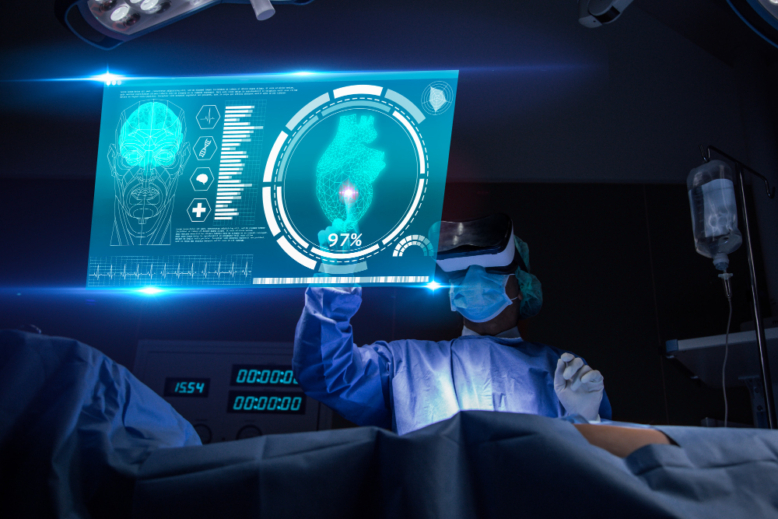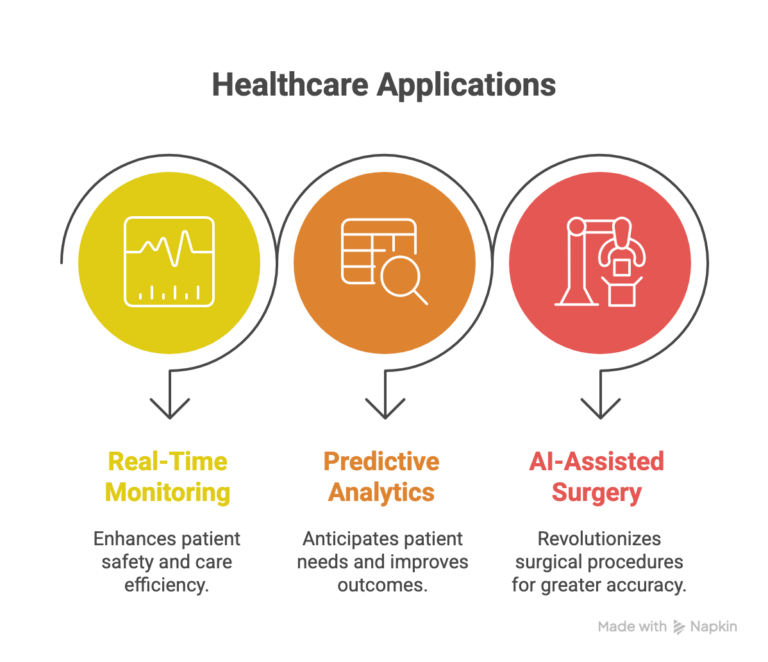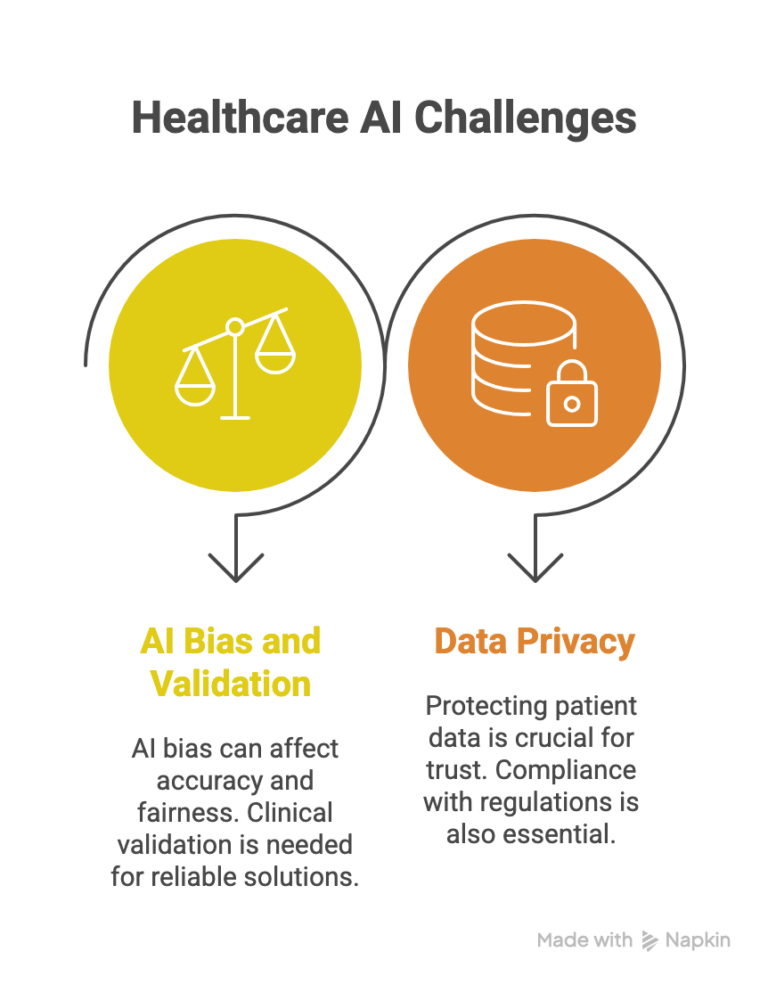Greetings! I'm Aneesh Sreedharan, CEO of 2Hats Logic Solutions. At 2Hats Logic Solutions, we are dedicated to providing technical expertise and resolving your concerns in the world of technology. Our blog page serves as a resource where we share insights and experiences, offering valuable perspectives on your queries.

Every 24 hours, hospitals experience approximately 685 preventable deaths from medical errors, many from misdiagnosed images, undetected patient deterioration, or delayed interventions.
Computer vision in healthcare eliminates the bottlenecks that plague manual processes: radiologist fatigue, monitoring gaps during shift changes, and the impossibility of continuously observing every at-risk patient. These are structural advantages that compound over time, not incremental improvements.
Through various implementations, we’ve identified where AI medical imaging creates the greatest value: diagnostic accuracy, patient monitoring, workflow automation, and predictive analytics. This guide outlines the path from pilot projects to enterprise-scale transformation, drawing on evidence from real deployment data.
What is Computer Vision and Why Does Healthcare Need It?
Computer vision represents artificial intelligence’s ability to interpret and analyze visual information from the world, in healthcare’s case, medical images, patient movements, and clinical environments. Think of it as giving machines the power to “see” and understand what doctors see, but with superhuman speed and consistency.
The evolution of AI imaging in healthcare has accelerated dramatically. From basic image enhancement in the 1970s to today’s deep learning algorithms that can detect cancer with 99% accuracy, we’ve entered an era where machines complement human expertise rather than replace it.
PRO TIP: When evaluating computer vision solutions, prioritize systems that augment clinical decision-making rather than replace it. The most successful implementations combine AI precision with human judgment.
AI in Medical Imaging
AI medical imaging has transformed how we detect, diagnose, and treat diseases. Traditional radiology requires specialists to review hundreds of images daily, a process prone to fatigue-related errors. Computer vision systems analyze these same images in seconds, flagging anomalies that might escape even experienced eyes.
Real-World Impact:
- Radiology: AI systems detect lung nodules in CT scans with 94% sensitivity, outperforming single radiologists
- Pathology: Digital pathology with AI identifies cancer biomarkers 30% faster than manual review
- Cardiology: Automated echocardiogram analysis predicts heart failure risk years before symptoms appear
A major academic medical center reported that after implementing AI-assisted medical imaging, their radiologists reviewed 23% more cases daily while reducing diagnostic errors by 37%.
WARNING: Not all AI medical imaging systems are FDA-approved or clinically validated. Always verify regulatory clearance and demand peer-reviewed evidence before implementation.
Ready to explore AI imaging for your facility?
Key Applications Transforming Healthcare

Real-Time Patient Monitoring
Computer vision cameras in patient rooms and hallways monitor movement patterns 24/7 without invasive wearables. These systems detect:
- Patient deterioration: Sudden changes in movement trigger nurse alerts
- Bed exit monitoring: Reduces falls by 40% in high-risk populations
One 500-bed hospital reduced patient falls from 6.2 to 2.8 per 1,000 patient-days after deploying computer vision monitoring, translating to 850 prevented falls annually.
Predictive Analytics in Healthcare
Beyond imaging, predictive analytics healthcare platforms integrate computer vision data with electronic health records to forecast:
- Sepsis onset: 4-6 hours earlier than traditional methods
- ICU readmission risk: With 85% accuracy
- Surgical complications: Identifying high-risk patients pre-operatively
AI-Assisted Surgical Precision
Surgical AI assistance brings unprecedented precision to operating rooms. Computer vision systems provide:
- Real-time anatomy recognition during laparoscopic procedures
- Instrument tracking to prevent retained surgical items
- Tremor stabilization for microsurgeries
- Augmented reality overlays showing tumor boundaries
Surgeons using AI-assisted systems report 43% fewer complications and 19% shorter operation times.
PRO TIP: Start with low-risk, high-volume procedures when implementing surgical AI. Build clinician confidence before expanding to complex cases.
Healthcare AI Trends 2025
The digital transformation in healthcare is accelerating:
- Market growth: Healthcare AI reached $11 billion in 2024, projected to hit $187 billion by 2030
- Adoption rates: 65% of hospitals now use some form of AI medical imaging
- ROI timeline: Average payback period is 14-18 months for computer vision implementations
Healthcare AI trends indicate that early adopters gain significant competitive advantages:
- 28% reduction in average length of stay
- 35% improvement in patient satisfaction scores
- $5.4 million annual savings for mid-sized hospitals
Workflow Automation in Hospitals
Computer vision extends beyond patient care into operational excellence:
Hospital Resource Optimization
- OR utilization: Vision systems track equipment and staff location, improving scheduling by 22%
- Supply chain: Automated inventory management reduces waste by 31%
- Staffing efficiency: Patient acuity assessment tools optimize nurse assignments
Infection Control and Safety
AI-powered cameras monitor:
- Hand hygiene compliance (improving rates from 65% to 94%)
- PPE usage in isolation rooms
- Social distancing in waiting areas
- Environmental cleaning verification
WARNING: Implementing workplace surveillance requires transparent policies, staff consent, and strict data privacy protections. Non-compliance can damage staff morale and trigger legal issues.
Concerned about implementation challenges?
Remote Patient Monitoring and Personalized Treatment
The pandemic accelerated remote patient monitoring adoption, with computer vision playing a crucial role:
Chronic Condition AI Management
Home-based vision systems monitor:
- Diabetes: Foot ulcer detection through smartphone cameras
- Respiratory disease: Breathing pattern analysis
- Cardiac conditions: Non-contact vital sign monitoring
- Mental health: Facial expression and activity analysis for depression screening
These technologies enable personalized treatment AI that adapts care plans based on continuous data streams rather than periodic clinic visits.
Overcoming Challenges

Data Privacy in Healthcare AI
Computer vision systems must comply with HIPAA, GDPR, and emerging AI regulations:
- Implement end-to-end encryption
- Anonymize patient data in training sets
- Conduct regular security audits
- Maintain transparent data governance policies
AI Bias and Clinical Validation
Historical training data often underrepresents certain demographics. To combat AI bias:
- Validate systems across diverse patient populations
- Require FDA clearance or CE marking
- Demand published clinical trial data
- Implement continuous performance monitoring
PRO TIP: Form a multidisciplinary AI governance committee including clinicians, IT, legal, and patient advocates before any deployment.
Success Stories
Radiology Department Transformation
A 300-bed community hospital implemented AI medical imaging for chest X-rays:
- Results: 51% reduction in missed lung nodules
- Efficiency: Radiologists reviewed 31% more cases daily
- ROI: System paid for itself in 11 months through reduced malpractice costs
Instrument Tracking Transformation in Surgery
A large hospital implemented an AI-powered instrument tracking integrated with computer vision for real-time surgical tool monitoring:
Results: Zero retained surgical items after procedures
Efficiency: 50% reduction in surgical tray instrument count and 25% faster tray setup
ROI: Up to $7 million annual savings through reduced errors and operational improvements
Conclusion
Computer vision in healthcare isn’t a distant future; it’s transforming patient care today. With medical errors still claiming hundreds of thousands of lives annually and healthcare costs spiraling, AI medical imaging and related technologies offer a path to safer, more efficient, more personalized care.
The question isn’t whether to adopt these digital health innovations, but when and how. Organizations that embrace workflow automation, healthcare, and predictive analytics now will lead the next decade of medical excellence.
FAQ
Will AI replace doctors?
No. Computer vision augments clinical expertise, handling routine tasks while clinicians focus on complex decision-making and patient relationships.
How accurate is AI medical imaging?
Top systems achieve 95-99% accuracy for specific tasks, often matching or exceeding human performance. However, no system is perfect—human oversight remains essential.
What about patient privacy?
Reputable systems encrypt data, anonymize images, and comply with healthcare regulations. Always verify vendor security credentials.

Related Articles







